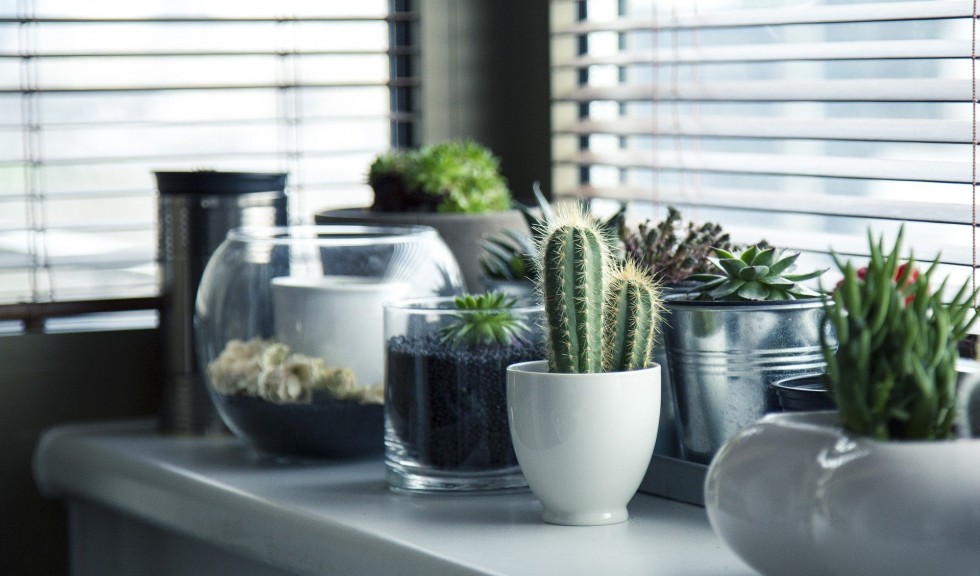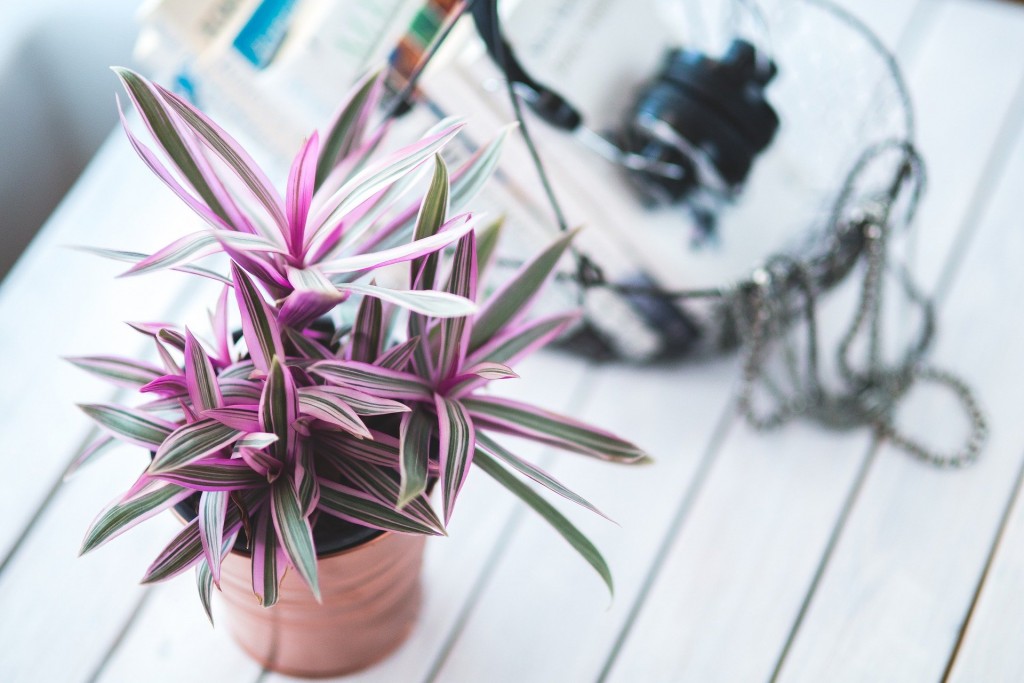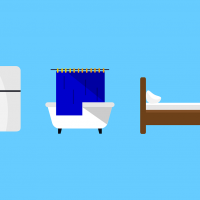Houseplants are not just another kind of home decor elements, as if they were, we could totally replace them with artificial flowers and plants in pots and notice no difference whatsoever. But, they really create a special atmosphere in our homes, making them more enliven, they connect people with nature even in crowded concrete cities, they generally make us feel better.
Aside from the undeniable aesthetic benefits, houseplants contribute to people’s health. It’s proven that they decrease the levels of carbon dioxide in the air, as they use it during the ongoing photosynthesis process. Meanwhile, plants saturate the air with oxygen, regulate the air’s humidity levels and absorb harmful substances emitted to the air with the cigarette smoke, so they’re exceptionally beneficial if there’s a smoker in your house. Some houseplants can be applied as medical treatment to relief pain, reduce swelling, treat a wound, cure acne and help with colds and nasal congestion.
Scientists even note that people who have houseplants at home tend to be less subject to stress, they’re much calmer. Moreover, taking care of plants helps people cope with depression and bad mood in general, they create a nice and stable atmosphere of well-being in the house. If you involve children in the process of growing and taking care of living plants, they’ll learn to appreciate nature and not to take it for granted from an early age. Some pediatricians recommend introducing different kinds of houseplants to your house if you have a newborn child to make your baby get used to different allergens and develop tolerance and even immunity to them. But, you have to be really careful doing that, especially if your child has already experienced problems with allergies. Then, it’s better not to worsen the situation and opt for not proactive, but symptomatic and systematic treatment.
But, no matter how people love having houseplants and enjoy taking care of them, they often face the situation, when no matter how hard they try and no matter what they do, a brand-new plant that was just brought from the store, dies after several weeks of staying at its new home. Can you relate? If yes, let’s figure out how to take care of houseplants properly and keep them alive not to commit the same mistakes over and over again.
1. Choosing a houseplant to suit your house and personality
First of all, you have to think carefully about which type of plants you prefer. There’re such plants that don’t grow too fact and too high, so they’re suitable for windowsills, tables and small stands for multiple pots. Floor plants always look impressive, but they also take up quite a lot of space and require special treatment measures and enough sunlight, which is sometimes hard to provide for a tall large plant. Decide if you like plants that produce flowers or don’t do that at all. Don’t make a mistake of bringing home a plant that’s supposed to grow outside, as it won’t flourish in the inappropriate circumstances for sure.
Also, you have to choose flowers according to the weather conditions in your local area. Too high temperatures and humidity levels, too much or too little sunlight will suit one kind of houseplant, but will be harmful to another. For instance, some plants prefer growing in places where there’s a lot of natural light and the air is not too humid, but others flourish in shaded areas and require abundant watering.
That’s why you have to see if your place will be suitable for the type of houseplant you’re willing to buy. Consult with a gardener or shop assistant to choose the proper ones.
2. For those who have a hard time keeping houseplants alive
If you always seem to have trouble with taking proper care of houseplants and all your previous experiences with them ended badly, I’d offer you choosing ‘safe options’ of plants, which are really hard to kill even for people without a green thumb and who’re not gardeners at all.
Of course, you can hire a gardener on HireRush.com and he will take proper professional care of both indoor and outdoor plants for you. He’ll have all necessary knowledge and skills to treat your greenery the best way possible. But, if you can’t afford his services or just don’t want to hire someone for such a matter, then you’ll have to learn how to treat plants on your own.
So, if you’re not one of those people who have a magic wand to take care of their houseplants with minimum effort and still end up with beautiful greenery in their houses, it’s better not to test your luck and start off with low maintenance houseplants. Those are either cactuses or succulents, but your choice is not limited by them. Plants with thick leaves, which are not used to hot and humid conditions, will be great as well. Check out Snake Plants, English Ivies, Peace Liles, Peperomia, Spider Plant, Rubber Tree, Dracena, Croton, etc. They don’t need too much sunlight and frequent watering.
3. Get in know your houseplants
I’ve already mentioned that various houseplants need different living conditions and care. Watering frequency, sunlight requirements, feeding substances and even soil they have to be planted in won’t be the same for different houseplant families and kinds. That’s why it’s better to figure out the names of your houseplants to be able to search for necessary maintenance information for this or that plant only. This way you’ll know for sure how you’re supposed to take care of each houseplant you have.
4. Watering routine
All plants require regular watering for sure. But, overwatering is a common mistake that might harm a houseplant even more than the lack of water, as the roots can’t stand too much moisture. On the other hand, when you know that you won’t be at home for several days, ask you friend our housekeeper to water your plants for you.
It’s pretty easy to tell when your plants need to be watered. Check the soil in a pot and if the ½ -1 inch layer feels dry, then it’s time to water. Basically, it needs to be done ‘on demand’. Watering intervals are different for various plants, so, again, learn the requirements first and then grab a bucket and pour some water into the pot.
Remember that flowering plants need to be watered more frequently than others, but some kinds can stand being dry for several days, and some of them even need it (like cacti).
However, professional gardeners note that houseplants’ water demand depends on the season and their living conditions. So, the challenging task of coming up with a perfect watering routine to ensure healthy plants’ growth is something you’ll have to cope with on your own. Luckily, you have some basic information about houseplants to use as guidelines.
5. How to clean a houseplant
Houseplants collect dust on their leaves, which has to be removed not only because dirty and dusty plants look bad and are harmful to human’s health (especially to those people, who suffer from dust allergies), but also because it’s not good for plants as well.
So, to wash houseplants, place them in sink or shower (depending on their size) and use room temperature water and shower hose to clean them. Don’t make the water flow too strong not to damage the plant. Make sure not to direct water onto the soil not to make it fall out of the pot. Leave a plant to drip for a little while before bringing it back to its original place.
Washing houseplants with big and wide leaves in shower won’t be effective. In fact, it’s better to wipe their leaves with a damp cloth.
Some plants, who have fuzzy leaves (like violets) don’t like to be washed with water. So, you’ll have to dust them with a paintbrush to get them cleaned.
6. Rotating and replanting
Houseplants tend to bend towards the sunlight, as usually they’re not lighted equally illuminated from all sides. In the long run, a plant may look weirdly because of that. Besides, if you don’t rotate a plant at all, it might lean to the side too much and even break under its own weight. That’s exactly why you should rotate houseplants regularly – for a quarter of a turn every 3 to 6 days. But, in order to make your life easier and always remember to rotate your pots, just include rotating into the watering routine. Turn your houseplants for a quarter of a full turn every time you water them or install artificial lighting on the shady side to avoid rotating.
Replanting is necessary to ensure enough living space for houseplants and their roots, so that the plant gets enough ‘nutrients’ from the soil.
7. Pest and disease control
Keep an eye on the state of the houseplant’s leaves. If you notice some unusual spots on leaves or that they became lighter in color, it often means that your plant has been attacked by insects. You have to isolate a plant immediately to prevent the pests from spreading onto other plants as well. The most common anti-pest treatment is to apply the insecticidal soap mixture onto the plant’s leaves. This will kill most of the soft-bodied bests, but only if you repeat the procedure several times a month (like one time a week).
Sometimes the soil where houseplants grow gets infected as well. It often happens because people overwater their plants. So, the way to kill soil pests is to let the soil stay dry more than usually and, if that doesn’t work, apply special chemicals or repot them into completely new ground.
Unfortunately, diseased plants have to be destroyed if the express treatment doesn’t work. It’s a sacrifice you can’t avoid. Otherwise, it will infect other houseplants and they’ll die as well.
8. Grooming and feeding
Remove yellow dry leaves and cut off dried flowers. Get rid of damaged and brown leaves as well using sharp scissors. These steps prevent spreading of houseplants diseases and generally make them look better. Sometimes it’s also necessary to prune the branches that are too long or too crooked to reach a balanced shape of the plant. But it’s not something you should do if you prefer a little bit wild-looking plants.
Moreover, cutting houseplant’s branches or pinching its top stems encourages better and faster growth. Besides, this gardener’s trick will help if your plant grows rapidly in height, but you want it look more thick and bushy. Then, you can pinch the side stems to promote the growth in width.
Fertilizing routine for plants should be well-thought and consistent, and, just like watering, it should be developed considering the houseplant’s peculiarities and its growth patterns. Besides, different plants require different feeding supplements, that’s why it’s necessary to learn which fertilizers are suitable for this or that plant not to overfeed a houseplant, burn its roots and slow down its growth rather than speed it up.
Generally, gardeners recommend feeding houseplants in spring and summer, as those are the period of their active growth anyway. Follow instructions on the packaging to use the right amount of fertilizer. As a rule, flowering houseplants require less feeding, as fertilizers promote the leaves’ growth much more than flowers’.






